University of Toronto
Toronto, Canada
eddie@comm.toronto.edu, roy.leung@utoronto.ca
A Design and Implementation of Active Network
Socket Programming
K.L. Eddie Law, Roy Leung
The Edward S. Rogers Sr. Department of Electrical and Computer Engineering
introduces programmability
Abstract—The concept of programmable nodes and active
networks
into communication
networks. Code and data can be sent and modified on their ways
to destinations. Recently, various research groups have designed
and implemented their own design platforms. Each design has its
own benefits and drawbacks.
Moreover, there exists an
interoperability problem among platforms. As a result, we
introduce a concept that is similar to the network socket
programming. We intentionally establish a set of simple
interfaces for programming active applications. This set of
interfaces, known as Active Network Socket Programming
(ANSP), will be working on top of all other execution
environments in future. Therefore, the ANSP offers a concept
that is similar to “write once, run everywhere.” It is an open
programming model that active applications can work on all
execution environments. It solves the heterogeneity within active
networks. This is especially useful when active applications need
to access all regions within a heterogeneous network to deploy
special service at critical points or to monitor the performance of
the entire networks. Instead of introducing a new platform, our
approach provides a thin, transparent layer on top of existing
environments that can be easily
installed for all active
applications.
Keywords-active networks; application programming interface;
active network socket programming;
I.
INTRODUCTION
In 1990, Clark and Tennenhouse [1] proposed a design
framework for introducing new network protocols for the
Internet. Since the publication of that position paper, active
network design framework [2, 3, 10] has slowly taken shape in
the late 1990s. The active network paradigm allows program
code and data to be delivered simultaneously on the Internet.
Moreover, they may get executed and modified on their ways
to their destinations. At the moment, there is a global active
network backbone, the ABone, for experiments on active
networks. Apart from the immaturity of the executing
platform, the primary hindrance on the deployment of active
networks on the Internet is more on the commercially related
issues. For example, a vendor may hesitate to allow network
routers to run some unknown programs that may affect their
expected routing performance. As a result, alternatives were
proposed to allow active network concept to operate on the
Internet, such as the application layer active networking
(ALAN) project [4] from the European research community.
In the ALAN project, there are active server systems located at
different places in the networks and active applications are
allowed to run in these servers at the application layer.
Another potential approach from the network service provider
is to offer active network service as the premium service class
in the networks. This service class should provide the best
Quality of Service (QoS), and allow the access of computing
facility in routers. With this approach, the network service
providers can create a new source of income.
The research in active networks has been progressing
steadily. Since active networks introduce programmability on
the Internet, appropriate executing platforms for the active
applications to execute should be established. These operating
platforms are known as execution environments (EEs) and a
few of them have been created, e.g., the Active Signaling
Protocol (ASP) [12] and the Active Network Transport System
(ANTS) [11]. Hence, different active applications can be
implemented to test the active networking concept.
With these EEs, some experiments have been carried out to
examine the active network concept, for example, the mobile
networks [5], web proxies [6], and multicast routers [7].
Active networks introduce a lot of program flexibility and
extensibility in networks. Several research groups have
proposed various designs of execution environments to offer
network computation within routers. Their performance and
potential benefits to existing infrastructure are being evaluated
[8, 9]. Unfortunately, they seldom concern the interoperability
problems when the active networks consist of multiple
execution environments. For example, there are three EEs in
ABone. Active applications written for one particular EE
cannot be operated on other platforms. This introduces another
problem of resources partitioning for different EEs to operate.
Moreover, there are always some critical network applications
that need to run under all network routers, such as collecting
information and deploying service at critical points to monitor
the networks.
In this paper, a framework known as Active Network
Socket Programming (ANSP) model is proposed to work with
all EEs. It offers the following primary objectives.
• One single programming interface is introduced for
writing active applications.
• Since ANSP offers the programming interface, the
design of EE can be made independent of the ANSP.
0-7803-7533-X/02/$17.00 (C) IEEE7674�
This enables a
enhancing future execution environments.
transparency
in developing and
• ANSP addresses the interoperability issues among
different execution environments.
• Through the design of ANSP, the pros and cons of
different EEs will be gained. This may help design a
better EE with improved performance in future.
The primary objective of the ANSP is to enable all active
applications that are written in ANSP can operate in the ABone
testbed . While the proposed ANSP framework is essential in
unifying the network environments, we believe that the
availability of different environments is beneficial in the
development of a better execution environment in future.
ANSP is not intended to replace all existing environments, but
to enable the studies of new network services which are
orthogonal
the designs of execution environments.
Therefore, ANSP is designed to be a thin and transparent layer
its
on
deployment relies on automatic code
the
underlying environments. As a result, the deployment of
ANSP at a router is optional and does not require any change to
the execution environments.
top of all execution environments.
Currently,
loading with
to
are developed based on the same capsule model, their
respective components and interfaces are different. Therefore,
programs written in one EE cannot run in anther EE. The
conceptual views of the programming models in ANTS and
ASP are shown in Figure 1.
Then
the users can specify
There are three distinct components in ANTS: application,
capsule, and execution environment.
There exist user
interfaces for the active applications at only the source and
destination routers.
their
customized actions to the networks. According to the program
function, the applications send one or more capsules to carry
out the operations. Both applications and capsules operate on
top of an execution environment that exports an interface to its
internal programming resources. Capsule executes its program
at each router it has visited. When it arrives at its destination,
the application at destination may either reply it with another
capsule or presents this arrival event to the user. One drawback
with ANTS is that it only allows “bootstrap” application.
II. DESIGN ISSUES ON ANSP
The ANSP unifies existing programming interfaces among
all EEs. Conceptually, the design of ANSP is similar to the
middleware design that offers proper translation mechanisms to
different EEs. The provisioning of a unified interface is only
one part of the whole ANSP platform. There are many other
issues that need to be considered. Apart from translating a set
of programming interfaces to other executable calls in different
EEs, there are other design issues that should be covered, e.g.,
•
•
•
•
•
a unified thread library handles thread operations
regardless of the thread libraries used in the EEs;
a global soft-store allows information sharing among
capsules that may execute over different environments
at a given router;
a unified addressing scheme used across different
environments; more importantly, a routing information
exchange mechanism should be designed across EEs to
obtain a global view of the unified networks;
a programming model that should be independent to
any programming languages in active networks;
and finally, a translation mechanism to hide the
heterogeneity of capsule header structures.
A. Heterogeneity in programming model
Each execution environment provides various abstractions
for its services and resources in the form of program calls. The
model consists of a set of well-defined components, each of
them has its own programming interfaces. For the abstractions,
capsule-based programming model [10] is the most popular
design in active networks. It is used in ANTS [11] and ASP
[12], and they are being supported in ABone. Although they
The authors appreciate the Nortel Institute for Telecommunications (NIT)
at the University of Toronto to allow them to access the computing facilities
for this research project.
Figure 1. Programming Models in ASP and ANTS.
In contrast, ASP does not limit its users to run “bootstrap”
applications. Its program interfaces are different from ANTS,
but there are also has three components in ASP: application
client, environment, and AAContext. The application client
can run on active or non-active host. It can start an active
application by simply sending a request message to the EE.
The client presents information to users and allows its users to
trigger actions at a nearby active router. AAContext is the core
of the network service and its specification is divided into two
parts. One part specifies its actions at its source and destination
routers. Its role is similar to that of the application in ANTS,
except that it does not provide a direct interface with the user.
The other part defines its actions when it runs inside the active
networks and it is similar to the functional behaviors of a
capsule in ANTS.
In order to deal with the heterogeneity of these two models,
ANSP needs to introduce a new set of programming interfaces
and map its interfaces and execution model to those within the
routers’ EEs.
B. Unified Thread Library
Each execution environment must ensure the isolation of
instance executions, so they do not affect each other or access
�
others’ information. There are various ways to enforce the
access control. One simple way is to have one virtual machine
for one instance of active applications. This relies on the
security design in the virtual machines to isolate services.
ANTS is one example that is using this method. Nevertheless,
the use of multiple virtual machines requires relatively large
amount of resources and may be inefficient in some cases.
Therefore, certain environments, such as ASP, allow network
services to run within a virtual machine but restrict the use of
their services to a limited set of libraries in their packages. For
instance, ASP provides its thread library to enforce access
control. Because of the differences in these types of thread
mechanism, ANSP devises a new thread library to allow
uniform accesses to different thread mechanisms.
C. Soft-Store
Soft-store allows capsule to insert and retrieve information
at a router, thus allowing more than one capsules to exchange
information within a network. However, problem arises when
a network service can execute under different environments
within a router. The problem occurs especially when a network
service inserts its soft-store information in one environment
and retrieves its data at a later time in another environment at
the same router. Due to the fact that execution environments
are not allowed to exchange information, the network service
cannot retrieve its previous data. Therefore, our ANSP
framework needs to take into account of this problem and
provides soft-store mechanism that allows universal access of
its data at each router.
D. Global View of a Unified Network
When an active application is written with ANSP, it can
execute on different environment seamlessly. The previously
smaller and partitioned networks based on different EEs can
now be merging into one large active network. It is then
necessary to advise the network topology across the networks.
However, different execution environments have different
addressing schemes and proprietary routing protocols. In order
to merge these partitions together, ANSP must provide a new
unified addressing scheme. This new scheme should be
interpretable by any environments
through appropriate
translations with the ANSP. Upon defining the new addressing
scheme, a new routing protocol should be designed to operate
among environments to exchange topology information. This
allows each environment in a network to have a complete view
of its network topology.
E. Language-Independent Model
Execution environment can be programmed
in any
programming language. One of the most commonly used
languages is Java [13] due to its dynamic code loading
capability. In fact, both ANTS and ASP are developed in Java.
Nevertheless, the active network architecture shown in Figure 2
does not restrict the use of additional environments that are
developed in other languages. For instance, the active network
daemon, anted, in Abone provides a workspace to execute
multiple execution environments within a router. PLAN, for
example, is implemented in Ocaml that will be deployable on
ABone in future. Although the current active network is
designed to deploy multiple environments that can be in any
programming languages, there lacks the tool to allow active
applications to run seamlessly upon these environments.
Hence, one of the issues that ANSP needs to address is to
design a programming model that can work with different
programming languages. Although our current prototype only
considers ANTS and ASP in its design, PLAN will be the next
target to address the programming language issue and to
improve the design of ANSP.
Figure 2. ANSP Framework Model.
F. Heterogeneity of Capsule Header Structure
The structures of the capsule headers are different in
different EEs. They carries capsule-related information, for
example, the capsule types, sources and destinations. This
information is important when certain decision needs to be
made within its target environment. A unified model should
allow
to be executed on different
environments. However, the capsule header prevents different
environments
information successfully.
Therefore, ANSP should carry out appropriate translation to the
header information before the target environment receives this
capsule.
its program code
its
to
interpret
III. ANSP PROGRAMMING MODEL
We have outlined the design issues encountered with the
ANSP. In the following, the design of the programming model
in ANSP will be discussed. This proposed framework provides
a set of unified programming interfaces that allows active
applications to work on all execution environments. The
framework is shown in Figure 2. It is composed of two layers
integrated within the active network architecture. These two
layers can operate independently without the other layer. The
upper layer provides a unified programming model to active
applications. The lower layer provides appropriate translation
procedure to the ANSP applications when it is processed by
different environments. This service is necessary because each
environment has its own header definition.
The ANSP framework provides a set of programming calls
which are abstractions of ANSP services and resources. A
capsule-based model is used for ANSP, and it is currently
extended to map to other capsule-based models used in ANTS
�
and ASP. The mapping possibility to other models remains as
our future works. Hence, the mapping technique in ANSP
allows any ANSP applications to access the same programming
resources in different environments through a single set of
interfaces. The mapping has to be done in a consistent and
transparent manner. Therefore, the ANSP appears as an
execution environment that provides a complete set of
functionalities to active applications. While in fact, it is an
overlay structure that makes use of the services provided from
the underlying environments. In the following, the high-level
functional descriptions of the ANSP model are described.
Then, the implementations will be discussed. The ANSP
programming model is based upon the interactions between
four components: application client, application stub, capsule,
and active service base.
Figure 3. Information Flow with the ANSP.
• Application Client: In a typical scenario, an active
application requires some means to present information
to its users, e.g., the state of the networks. A graphical
user interface (GUI) is designed to operate with the
application client if the ANSP runs on a non-active
host.
• Application Stub: When an application starts,
it
activates the application client to create a new instance
of application stub at its near-by active node. There
are two responsibilities for the application stub. One of
them
the
application client. Another one is to receive incoming
capsules from networks and to perform appropriate
actions. Typically, there are two types of actions, that
to receive users’
is
instructions from
are, to reply or relay in capsules through the networks,
or to notify the users regarding the incoming capsule.
• Capsule: An active application may contain several
capsule types. Each of them carries program code
(also referred to as forwarding routine). Since the
application defines a protocol
the
interactions among capsules as well as the application
stubs. Every capsule executes its forwarding routine at
each router it visits along the path between the source
and destination.
specify
to
• Active Service Base: An active service base is designed
to export routers’ environments’ services and execute
program calls from application stubs and capsules from
different EEs. The base is loaded automatically at each
router whenever a capsule arrives.
The interactions among components within ANSP are
shown in Figure 3. The designs of some key components in the
ANSP will be discussed in the following subsections.
A. Capsule (ANSPCapsule)
ANSPXdr decode()
ANSPXdr encode()
int length()
Boolean execute()
New types of capsule are created by extending the abstract
class ANSPCapsule. New extensions are required to define
their own forwarding routines as well as their serialization
procedures. These methods are indicated below:
The execution of a capsule in ANSP is listed below. It is
similar to the process in ANTS.
1. A capsule is in serial binary representation before it is
sent to the network. When an active router receives a
byte sequence, it invokes decode() to convert the
sequence into a capsule.
2. The router invokes the forwarding routine of the
capsule, execute().
3. When the capsule has finished its job and forwards
itself to its next hop by calling send(), this call
implicitly invokes encode() to convert the capsule
into a new serial byte representation. length() is
used inside the call of encode() to determine the
length of the resulting byte sequence.
ANSP provides a XDR library called ANSPXdr to ease the
jobs of encoding and decoding.
B. Active Service Base (ANSPBase)
In an active node, the Active Service Base provides a
unified interface to export the available resources in EEs for the
rest of the ANSP components. The services may include
thread management, node query, and soft-store operation, as
shown in Table 1.
�
TABLE I.
Function Definition
boolean send(Capsule,
Address)
ANSPAddress
getLocalHost()
boolean
isLocal(ANSPAddress)
createThread()
putSStore(key,
Object)
Object getSStore(key)
removeSStore(key)
forName(PathName)
ACTIVE SERVICE BASE FUNCTION CALLS
Description
a
its
true
This
capsule
towards
Transmit
its
destination using the routing table of the
underlying environment.
Return address of the local host as an
ANSPAddress structure.
is
useful when a capsule wants to check its
current location.
Return
input argument
if
matches the local host’s address and
return false otherwise.
Create a new thread that is a class of
ANSPThreadInterface (discussed
later in Section VIA “Unified Thread
Abstraction”).
The soft-store operations are provided
by putSStore(), getSSTore(),
and removeSStore(), and they put,
retrieve, and remove data respectively.
in
Supported in ANSP to retrieve a class
object corresponding to the given path
name
its argument. This code
retrieval may rely on the code loading
mechanism in the environment when
necessary.
C. Application Client (ANSPClient)
boolean start(args[])
boolean start(args[],runningEEs)
boolean start(args[],startClient)
boolean start(args[],startClient, runningEE)
Application Client is an interface between users and the
following
It does
router.
the
nearby active source
responsibilities.
1. Code registration: It may be necessary to specify the
location and name of the application code in some
execution environments, e.g., ANTS.
2. Application initialization: It includes selecting an
execution environment to execute the application
among those are available at the source router.
Each active application can create an application client
instance by extending the abstract class, ANSPClient. The
extension inherits a method, start(), to automatically
handle both the registration and initialization processes. All
overloaded versions of start() accept a list of arguments,
args, that are passed to the application stub during its
initialization. An optional argument called runningEEs
allows an application client to select a particular set of
environment variables, specified by a list of standardized
numerical environment ID, the ANEP ID, to perform code
registration. If this argument is not specified, the default
setting can only include ANTS and ASP.
D. Application Stub (ANSPApplication)
receive(ANSPCapsule)
Application stubs reside at the source and destination
routers to initialize the ANSP application after the application
clients complete the initialization and registration processes. It
is responsible for receiving and serving capsules from the
networks as well as actions requested from the clients. A new
instance is created by extending the application client abstract
class, ANSPApplication. This extension includes the
definition of a handling routine called receive(), which is
invoked when a stub receives a new capsule.
IV. ANSP EXAMPLE: TRACE-ROUTE
A testbed has been created to verify the design correctness
of ANSP in heterogeneous environments. There are three
types of router setting on this testbed:
1. Router that contains ANTS and a ANSP daemon
running on behalf of ASP;
2. Router that contains ASP and a ANSP daemon that
runs on behalf of ANTS;
The program records
3. Router that contains both ASP and ANTS.
The prototype is written in Java [11] with a traceroute
testing program.
the execution
environments of all intermediate routers that it has visited
between the source and destination. It also measures the RTT
between them. Figure 4 shows the GUI from the application
client, and it finds three execution environments along the path:
ASP, ANTS, and ASP. The execution sequence of the
traceroute program is shown in Figure 5.
Figure 4. The GUI for the TRACEROUTE Program.
it
if
it checks
to determine
the ANSPCapsule abstract class.
The TraceCapsule program code
is created by
When
extending
the Boolean value of
execute() starts,
returning
is returning from
the
destination. It is set to true if TraceCapsule is traveling
back to the source router; otherwise it is false. When
traveling towards the destination, TraceCapsule keeps
track of the environments and addresses of the routers it has
visited in two arrays, path and trace, respectively. When it
arrives at a new router, it calls addHop() to append the router
address and its environment to these two arrays. When it
finally arrives at the destination, it sets returning to false
and forwards itself back to the source by calling send().
�
When it returns to source, it invokes deliverToApp() to
deliver itself to the application stub that has been running at the
source. TraceCapsule carries information in its data field
through
the networks by executing encode() and
decode(), which encapsulates and de-capsulates its data
using External Data Representation (XDR) respectively. The
syntax of ANSP XDR follows the syntax of XDR library from
ANTS. length() in TraceCapsule returns the data length, or
it can be calculated by using the primitive types in the XDR
library.
Figure 5. Flow of the TRACEROUTE Capsules.
V. CONCLUSIONS
In this paper, we present a new unified layered architecture
for active networks. The new model is known as Active
Network Socket Programming (ANSP). It allows each active
to be written once and
application
run on multiple
environments in active networks. Our experiments successfully
verify the design of ANSP architecture, and it has been
successfully deployed to work harmoniously with ANTS and
ASP without making any changes to their architectures. In
fact, the unified programming interface layer is light-weighted
and can be dynamically deployable upon request.
REFERENCES
[1] D.D. Clark, D.L. Tennenhouse, “Architectural Considerations for a New
Generation of Protocols,” in Proc. ACM Sigcomm’90, pp.200-208, 1990.
[2] D. Tennenhouse, J. M. Smith, W. D. Sicoskie, D. J. Wetherall, and G. J.
Minden, “A survey of active network research,” IEEE Communications
Magazine, pp. 80-86, Jan 1997.
[3] D. Wetherall, U. Legedza, and J. Guttag, “Introducing new internet
services: Why and how,” IEEE Network Magazine, July/August 1998.
[4] M. Fry, A. Ghosh, “Application Layer Active Networking,” in Computer
Networks, Vol.31, No.7, pp.655-667, 1999.
[5] K. W. Chin, “An Investigation into The Application of Active Networks
to Mobile Computing Environments”, Curtin University of Technology,
March 2000.
[6] S. Bhattacharjee, K. L. Calvert, and E. W. Zegura, “Self Organizing
Wide-Area Network Caches”, Proc. IEEE INFOCOM ’98, San
Francisco, CA, 29 March-2 April 1998.
[7] L. H. Leman, S. J. Garland, and D. L. Tennenhouse, “Active Reliable
Multicast”, Proc. IEEE INFOCOM ’98, San Francisco, CA, 29 March-2
April 1998.
[8] D. Descasper, G. Parulkar, B. Plattner, “A Scalable, High Performance
Active Network Node”, In IEEE Network, January/February 1999.
[9] E. L. Nygren, S. J. Garland, and M. F. Kaashoek, “PAN: a high-
performance active network node supporting multiple mobile code
system”, In the Proceedings of the 2nd IEEE Conference on Open
Architectures and Network Programming (OpenArch ’99), March 1999.
[10] D. L. Tennenhouse, and D. J. Wetherall. “Towards an Active Network
Architecture”, In Proceeding of Multimedia Computing and Networking,
January 1996.
[11] D. J. Wetherall, J. V. Guttag, D. L. Tennenhouse, “ANTS: A toolkit for
Building and Dynamically Deploying Network Protocols”, Open
Architectures and Network Programming, 1998 IEEE , 1998 , Page(s):
117 –129.
[12] B. Braden, A. Cerpa, T. Faber, B. Lindell, G. Phillips, and J. Kann.
“Introduction to the ASP Execution Environment”: www.isi.edu/active-
signal/ARP/index.html.
[13] “The java language: A white paper,” Tech. Rep., Sun Microsystems,
1998.
�
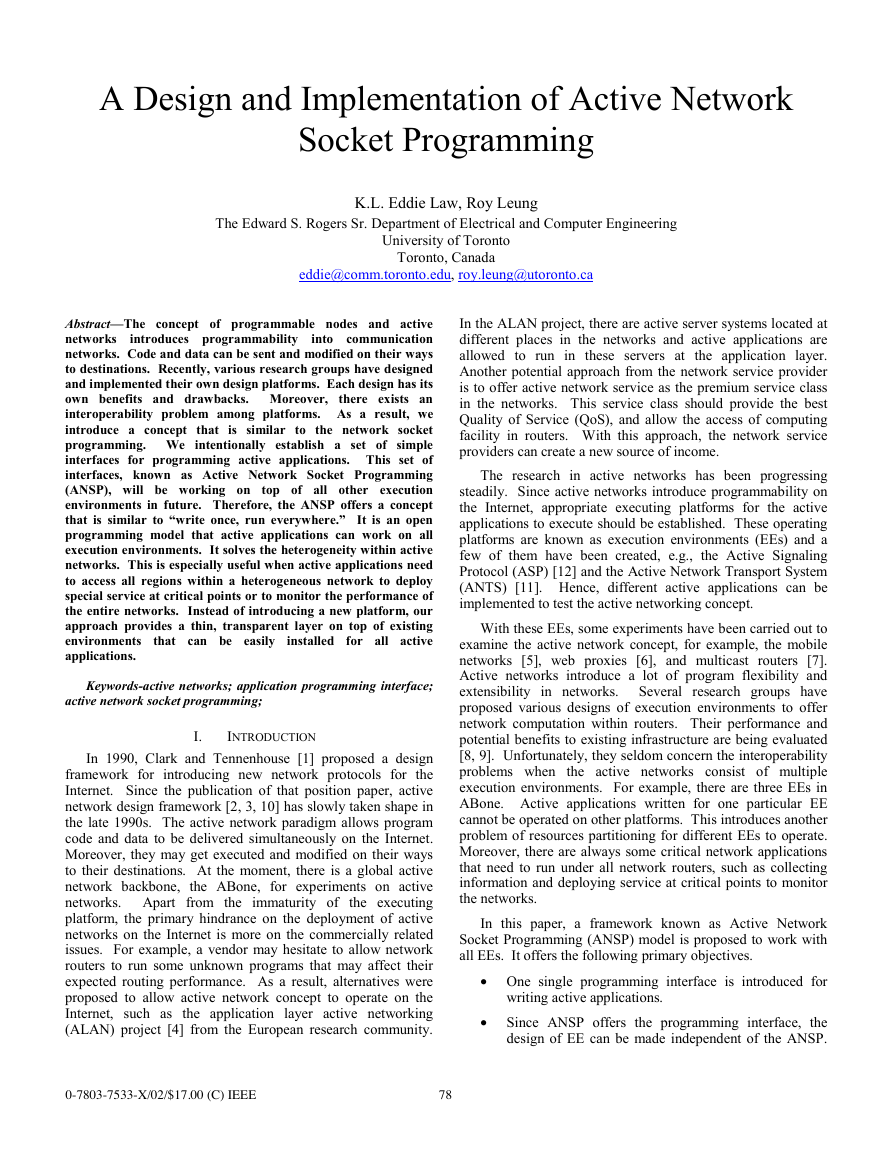

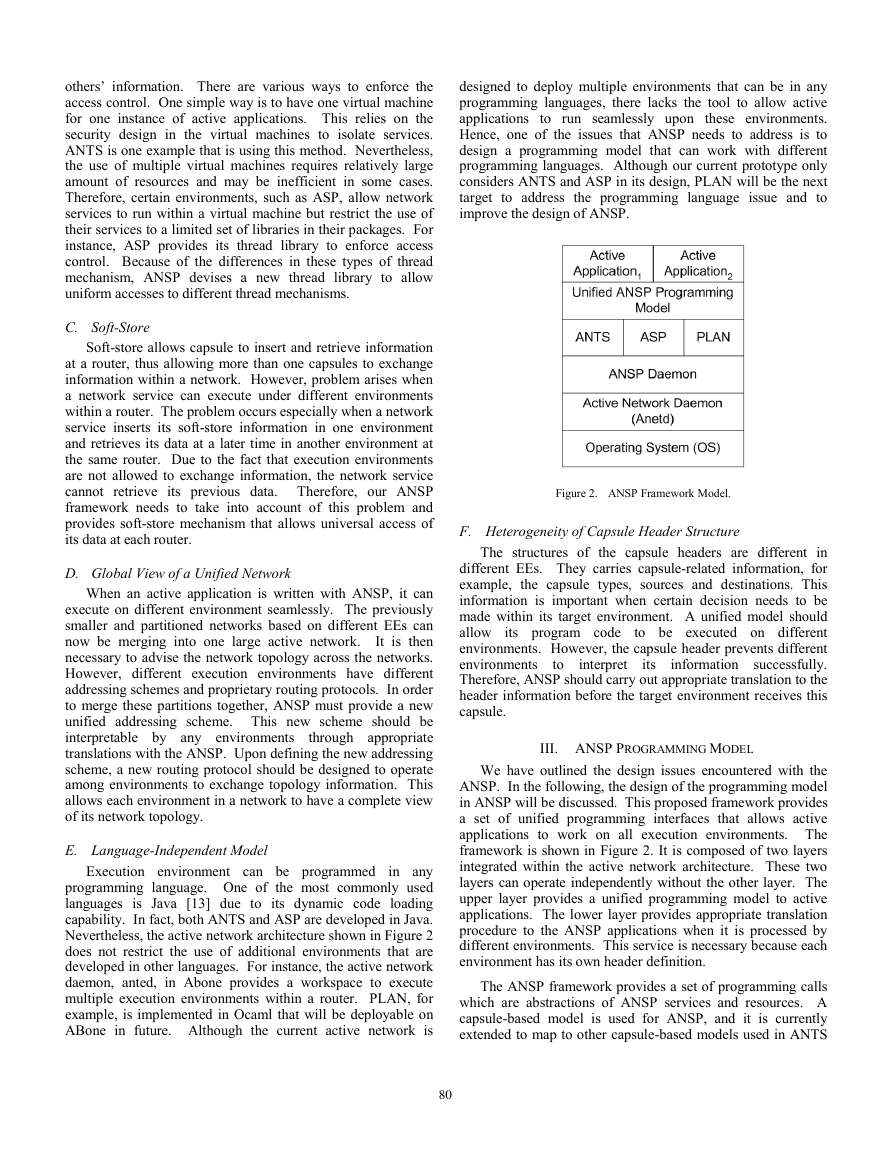
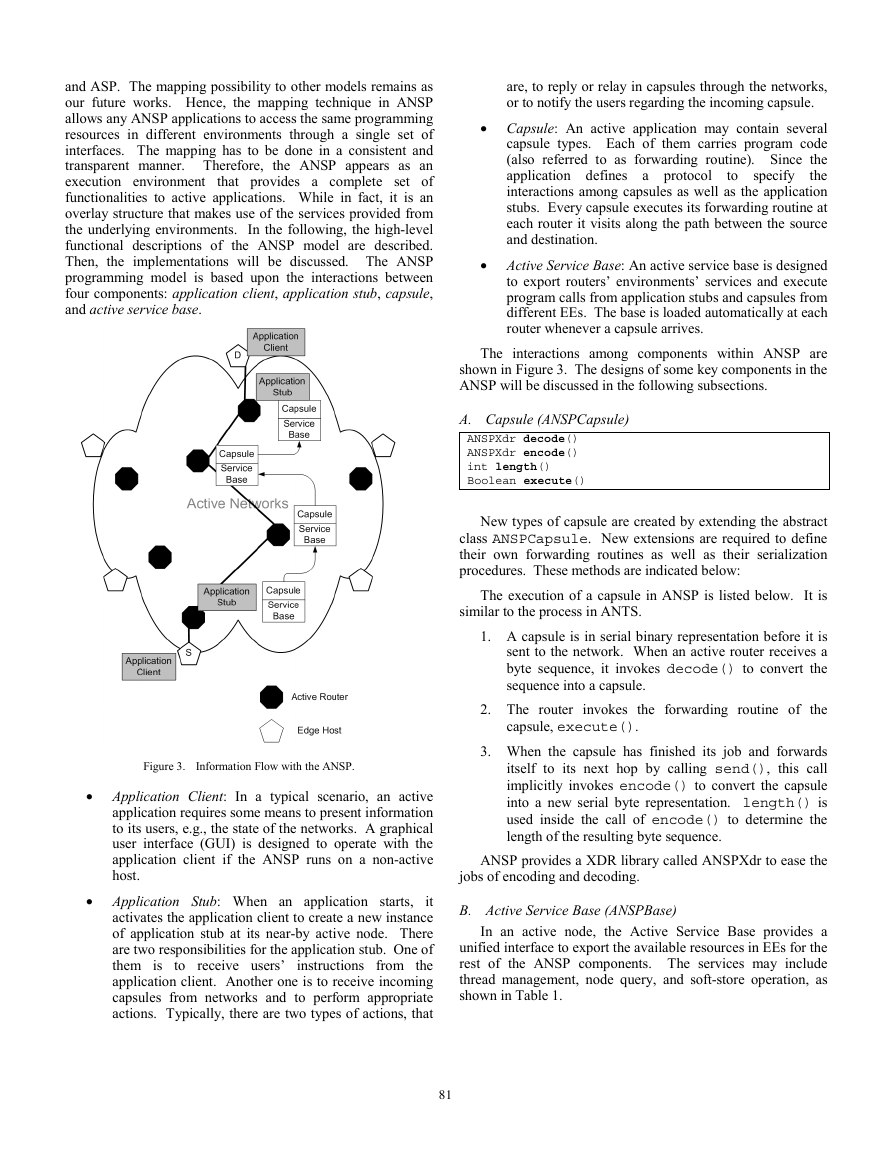
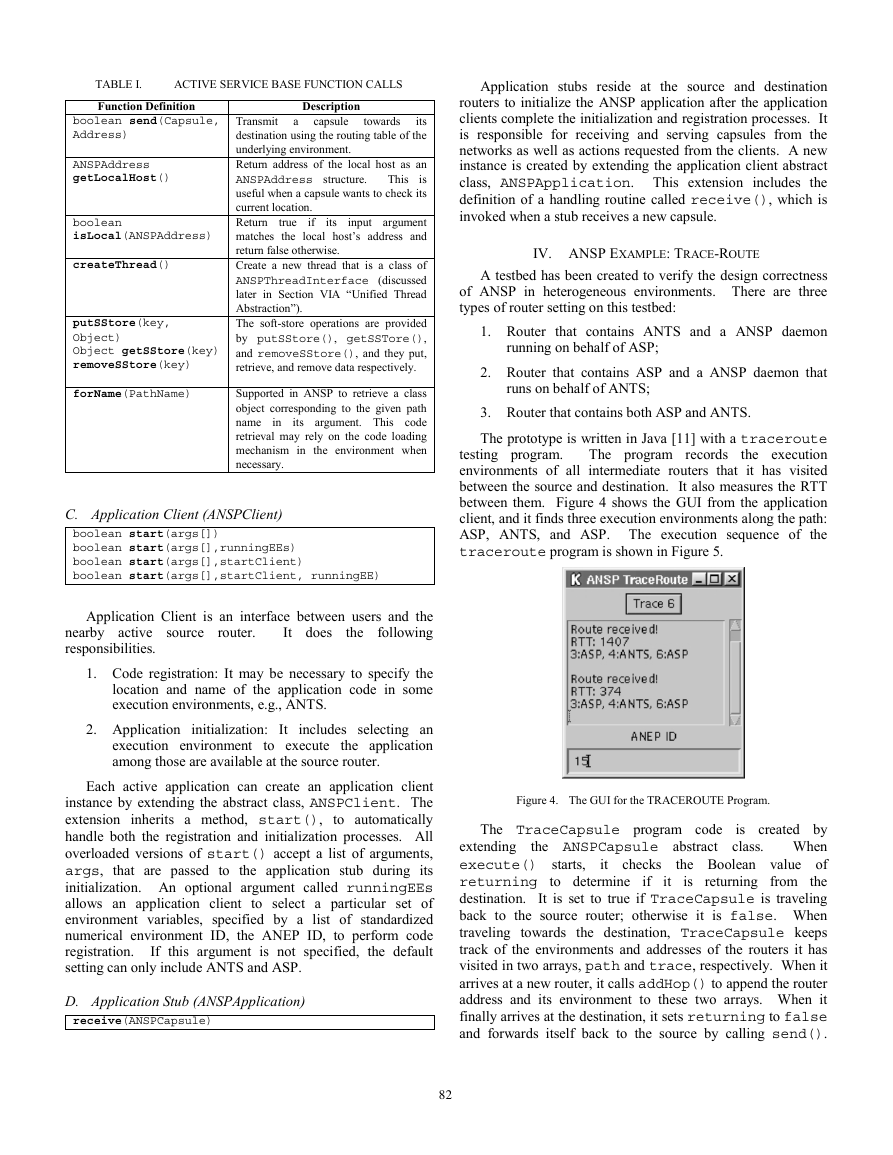
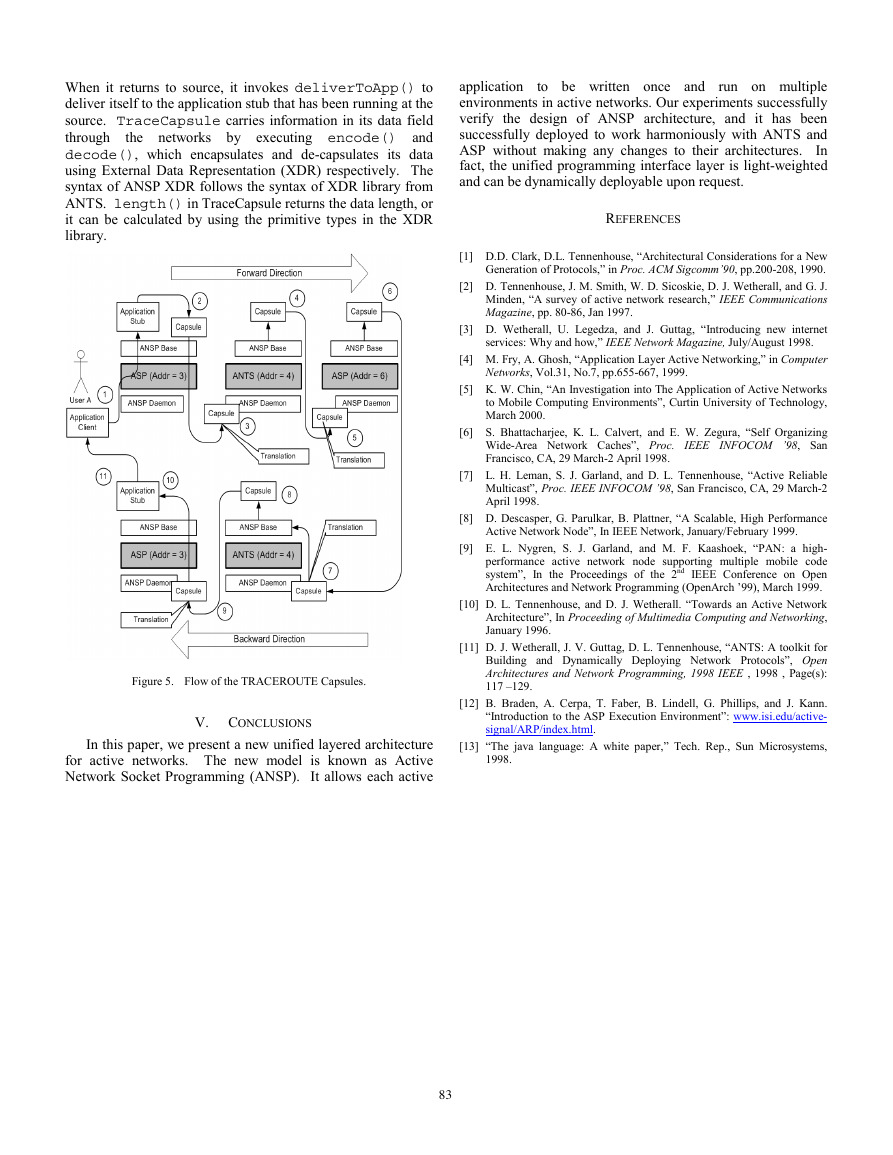






 2023年江西萍乡中考道德与法治真题及答案.doc
2023年江西萍乡中考道德与法治真题及答案.doc 2012年重庆南川中考生物真题及答案.doc
2012年重庆南川中考生物真题及答案.doc 2013年江西师范大学地理学综合及文艺理论基础考研真题.doc
2013年江西师范大学地理学综合及文艺理论基础考研真题.doc 2020年四川甘孜小升初语文真题及答案I卷.doc
2020年四川甘孜小升初语文真题及答案I卷.doc 2020年注册岩土工程师专业基础考试真题及答案.doc
2020年注册岩土工程师专业基础考试真题及答案.doc 2023-2024学年福建省厦门市九年级上学期数学月考试题及答案.doc
2023-2024学年福建省厦门市九年级上学期数学月考试题及答案.doc 2021-2022学年辽宁省沈阳市大东区九年级上学期语文期末试题及答案.doc
2021-2022学年辽宁省沈阳市大东区九年级上学期语文期末试题及答案.doc 2022-2023学年北京东城区初三第一学期物理期末试卷及答案.doc
2022-2023学年北京东城区初三第一学期物理期末试卷及答案.doc 2018上半年江西教师资格初中地理学科知识与教学能力真题及答案.doc
2018上半年江西教师资格初中地理学科知识与教学能力真题及答案.doc 2012年河北国家公务员申论考试真题及答案-省级.doc
2012年河北国家公务员申论考试真题及答案-省级.doc 2020-2021学年江苏省扬州市江都区邵樊片九年级上学期数学第一次质量检测试题及答案.doc
2020-2021学年江苏省扬州市江都区邵樊片九年级上学期数学第一次质量检测试题及答案.doc 2022下半年黑龙江教师资格证中学综合素质真题及答案.doc
2022下半年黑龙江教师资格证中学综合素质真题及答案.doc